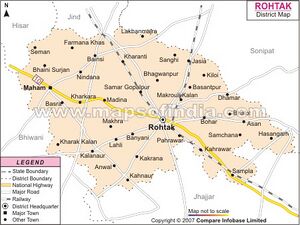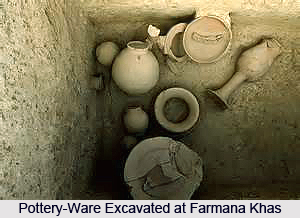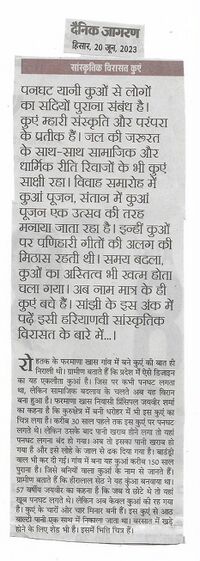Farmana Khas

Farmana Khas (फरमाणा खास) is an historical village in Maham tahsil of Rohtak district, Haryana. It is a site of Indus Valley Civilisation.
Location
Farmana Khas or Daksh Khera is an archaeological site in Meham block of Rohtak district in northern Indian state of Haryana spread over 18.5 hectares. It is located near the village of Farmana Khas, about 15 kilometers from the Rohtak-Hissar highway and 60 kms from Delhi. It is significant particularly for its burial site, with 70 burials, of the Mature Harappan period (2500–2000 BC) and fairly recent addition (excavation started during 2006)[1][2] to Indus Valley Civilisation sites excavated in India.[3]
Jat Gotras
Site of Indus Valley Civilisation

This site was excavated under the direction of Vasant Shinde of the Deccan College Post Graduate and Research Institute, Pune. The project was financed by the Research Institute for Humanity and Nature, Kyoto, which also provided technical expertise. The Maharshi Dayanand University, Rohtak and Deccan College Post Graduate and Research Institute, Pune under the aegis of the Archaeological Survey of India (ASI) are the Indian partners of the project.[5][6]
Architecture and material culture: The site is divided in two areas, one for the living and one for the dead, separated by a distance of 1 km. The finds were made in intensely cultivated, flat land. The habitation site is spread over 18.5 hectare. Excavation has revealed a well-laid-out road with houses on either side.
Complex with 26 rooms: The site has four complexes and so far one complex has been excavated which has 26 rooms, 3 to 4 kitchens, an equal number of bathrooms and a courtyard in the centre.[7] Terracotta toys, whistle, wheels and seals, copper bangles, a small ornament of gold and large amount of pottery has been retrieved.
70 burials: The cemetery at Farmana has revealed 70 burials so far and has been assigned to the Mature Harappan phase (2500–2000 BC), whereas the burial site at Sanauli, in the Baghpat district of Utter Pradesh, which revealed 116 graves, belongs to a later stage of Harappan culture.[8] Most of the graves are oriented northwest-southeast, though there are some with north-south and northeast-southwest orientations as well.[9] Notable amongst them is a skeleton of a middle-aged woman, which had three shell bangles, two copper bangles, copper earrings, beads and ornaments on the feet, indicating her wealthy status.[10]
Scientific testing: Vasant Shinde announced in March 2009 the intention to conduct scientific tests on skeletal remains, pottery and botanical evidence found at the site, including DNA tests on bones to attempt to establish the origins of the Harappans, and trace element analyses to help understand their diet.[11]
Four-thousand-year-old teeth from skeletal remains in Harappa cemetery & Farmana were examined. Human dental enamels were compared and chemical analysis of water, fauna, rocks of those times using ratio of lead & strontium ration was done. Differences in early molars and late morals indicate people living in Indus Valley Cities migrated from countryside to urban areas.[12]
The team also plans to carry out coring tests in lakes around the Farmana site to ascertain climatic conditions prevalent at the time of the Harappan civilization, and investigate whether the decline of the culture followed catastrophic climate change.[13]
Plant use and dietary practices: Study of Starch Grains which are plant microfossils, obtained from storing and cooking ceramic vessels, stone tools as well as dental calculus of burials has shed a light on plant usage in Indus Valley Civilization. Use of wheat, barley, millet, gram, garlic whose seeds were found and use of horsegram, eggplant, mango, ginger, turmeric, sedge whose seeds were not found, has been confirmed.[14]
Presence of cooked ginger & turmeric starch grains inside ceramic pots & teeth of skeletons in burial sites make Farmana (Indus Valley) first civilization to use spices for cooking.[15][16]
Other findings: A recent advance in the study have shown evidence of inter-regional marriage performed by the Harappans for trade purposes as well.[17]
Bangles and beads made out of conch shells from Gujarat were also found at this site.[18]
History

सन्दर्भ - वेब दुनिया बी.बी.सी. हिन्दी
हरियाणा के फरमाना गाँव में हड़प्पाकालीन सभ्यता ने नए अवशेष मिले हैं, जिनकी जाँच से हजारों साल पुरानी सभ्यता से जुड़े कई सवालों के जवाब मिल सकते हैं।
हरियाणा में इससे पहले भी राखीगढ़ी, मीताथल और बनावली में हड़प्पाकालीन स्थल मिले हैं, लेकिन फरमाना में पहली बार हड़प्पा काल के दो अलग-अलग समय के अवशेष एक साथ में मिले हैं।
इतना ही नहीं, फरमाना में पहली बार बड़ी संख्या में कब्रगाहें भी मिली हैं, जो तब के कई रीति-रिवाजों के बारे में जानकारियाँ दे सकती हैं।
फरमाना में खुदाई का काम डेक्कन कॉलेज के पुरातत्वविद् वसंत शिंदे के जिम्मे है। वे इस स्थान पर पिछले तीन वर्षों से खुदाई कर रहे हैं।
दक्षिण एशिया में पाकिस्तान से लेकर भारत तक मिली सिंधु घाटी सभ्यता का नाम हड़प्पा और मोहनजोदड़ो से जुड़ा हुआ है और ये दोनों स्थान पाकिस्तान में हैं।
सिंधु नदी सभ्यता के सबसे महत्वपूर्ण अवशेष यहीं मिले थे। इसका समय 2600 ईसा पूर्व से 1500 ईसा पूर्व तक माना जाता है, लेकिन लिपि अभी तक नहीं पढ़े जाने के कारण इसके बारे में जानकारी काफी कम है।
फरमाना से कुछ दूर खुदाई का काम हुआ है और करीब एक एकड़ क्षेत्र में हड़प्पाकालीन घरों के अवशेष देखे जा सकते हैं। खुदाई के काम में लगे एक छात्र बताते हैं यहाँ आप हड़प्पा स्टाइल के घर देख सकते हैं। सड़कें सीधी और नब्बे डिग्री के कोण पर मुड़ती हैं, जो मोहनजोदड़ों में भी दिखता है। इसके अलावा घरों के दरवाजे पूर्व की तरफ हैं।
इस खुदाई स्थल पर फिलहाल 27 कमरों की नींव मिली हैं, जिससे अंदाजा लगाया जा सकता है कि यहाँ कितने लोग रहते होंगे। इन कमरों में रसोई जैसी आकृतियाँ देखी जा सकती हैं, जिनके पास बर्तन के टुकड़े भी पाए गए हैं।
शिंदे फरमाना का महत्व बताते हुए कहते हैं कि इससे हड़प्पा काल के लोगों के बारे में कई तरह की जानकारियाँ मिल सकती हैं। वे कहते हैं यहाँ हमें जो भी घर और सामान मिला है, वह हड़प्पाकालीन अन्य सामानों जैसा है। मुहरें, आभूषण, जेवर और घरों की आकृत्तियाँ हड़प्पा जैसी हैं, इसलिए इसमें कोई शक नहीं है कि यह हड़प्पाकालीन स्थल है।
वे कहते हैं पहली बार हमें एक ही स्थान पर हड़प्पा के अलग-अलग समय के अवशेष मिले हैं, जिससे यह पता चलेगा कि लोगों का जीवन विभिन्न काल में कैसे बदलता रहा। जो कब्रगाहों में नरकंकाल मिले हैं, उससे यह पता लग सकता है कि वे लोग क्या खाते थे, शाकाहारी थे या माँसाहारी। क्या वे बाहर से आए थे या फिर स्थानीय थे, इन सवालों के जवाब डीएनए टेस्ट और अन्य परीक्षणों से पता चल सकते हैं।
शिंदे बताते हैं कि यहाँ मिले सामानों के आधार पर वे तत्कालीन जलवायु के बारे में भी जानकारी जुटाने की कोशिश करेंगे। उनके मुताबिक हड़प्पा या सिंधु नदी सभ्यता कैसे खत्म हुई थी, इसका सही जवाब अभी तक नहीं मिल सका है।
यह कहा जाता है कि जलवायु और संस्कृति का संबंध रहता है। जलवायु का पुनर्निर्माण कर हम यह पता लगा सकते हैं कि इस सभ्यता पर जलवायु का क्या असर रहा होगा। हालाँकि शिंदे की बात से अन्य पुरातत्वविद इत्तेफाक नहीं रखते हैं।
जवाहरलाल नेहरू विश्वविद्यालय की पुरातत्वविद की प्रोफेसर सुप्रिया वर्मा कहती हैं कि मैं फरमाना गई हूँ। वहाँ पर काफी सामान हड़प्पा काल का है, यह कहा जा सकता है।
...लेकिन बर्तनों के कई टुकड़े बाद के समय के हैं और कुछ सामान तो दूसरी या तीसरी सदी का भी है। सुप्रिया जलवायु पुनर्निर्माण की थ्योरी को भी नहीं मानतीं। उनका कहना है किसी नदी के सूख जाने से कोई सभ्यता नहीं खत्म हो जाती है।
वे कहती हैं कि हड़प्पा या कोई भी पुरानी सभ्यता अपने राजनीतिक और सामाजिक मतभेदों के कारण खत्म होती है। किसी नदी के सूख जाने से या अधिक बारिश मात्र होने से सभ्यताएँ खत्म नहीं होतीं।
असल में हड़प्पा की सभ्यता के बारे में दो प्रश्न सबसे अधिक विवादास्पद रहे हैं। एक तो यह सभ्यता खत्म कैसे हुई और दूसरा इस सभ्यता का आर्यों के आगमन से क्या संबंध था।
शिंदे कहते हैं कि इस बारे में अभी भी आँकड़े उपलब्ध नहीं हैं और इस पर और अधिक काम किए जाने की जरूरत है, जिसमें फरमाना से मिली चीजें एक बड़ी भूमिका निभा सकती हैं।
असल में इन प्रश्नों पर इतिहासकारों में बड़ा मतभेद है। जहाँ कुछ इतिहासकार सिंधु घाटी सभ्यता को मिथकीय नदी सरस्वती से जोड़कर देखते हैं, वहीं अन्य इतिहासकार सरस्वती के सूखने और सभ्यता के खत्म होने के सिद्धांत को नहीं मानते हैं।
जो भी घर और सामान मिला है, वह हड़प्पाकालीन अन्य सामानों जैसा है। मुहरें, आभूषण, जेवर और घरों की आकृत्तियाँ हड़प्पा जैसी हैं, इसलिए इसमें कोई शक नहीं है कि यह हड़प्पाकालीन स्थल है।
...लेकिन इतना मतभेद क्यों? सुप्रिया कहती हैं पुरातत्व में ये मतभेद हमेशा रहेंगे, क्योंकि जो लिखा जा चुका है, उसमें आप अधिक फेरबदल नहीं कर सकते। लेकिन जो खुदाई में सामान मिलता है, उसका विश्लेषण आप अपने हिसाब से कर सकते हैं। इसमें अपना मत डालने की संभावना बढ़ जाती है।
बहरहाल कुछ लोग इसे ये सरस्वती से जुड़ी सभ्यता बता रहे थे। स्थानीय विधायक ने यहाँ तक कहा कि मानव सभ्यता का उदय इसी स्थान से हुआ है। दूसरे व्यक्ति का कहना था सरस्वती यहीं से बहती थी।
मन में यह भ्रम हुआ कि कहीं पुरातत्व को मिथक से जोड़ने की कोशिश तो नहीं हो रही है। सुप्रिया से जब मैंने यह पूछा तो उनका कहना था कि पुरातत्व और राष्ट्र निर्माण का हमेशा से संबंध रहा है।
आप अपने भविष्य निर्माण के लिए हमेशा से एक महान भूतकाल का हवाला देते हैं और यहीं से मिथकों का बनना शुरू हो जाता है। सरस्वती से सिंधु घाटी सभ्यता को जोड़ने की शुरुआत भी ऐसा ही एक प्रयास है जो सही नहीं है।
इतिहास और पुरातत्व का पुराना रिश्ता रहा है और किसी भी स्थल के बारे में अलग-अलग मत आते रहते हैं और आते ही रहेंगे।
जरूरत है इन प्राचीन स्थलों के असली महत्व को पहचानने की, क्योंकि ये किसी देश या राष्ट्र की धरोहर नहीं है, बल्कि मानव सभ्यता की धरोहर हैं।
Another village of this name
Farmana Majra falls in Sonipat district of Haryana.
Famous People
Neelam Jaswant singh.(Arjuna awardee in Discuss Throw.)
Population
Population of Farmana Khas, according to Census 2011 stood at 9707 including males 5232 and females 4475.
External Links
- An Interesting article by Ranbir Singh about Farmana Khas http://www.tribuneindia.com/2000/20000422/windows/main1.htm
References
- ↑ Times of India.10.10.2011
- ↑ 65 graves point to largest Harappan burial site next door to capital, Indian Express 3 March 2009.
- ↑ Vasant Shinde, Toshiki Osada, Akinori Uesugi (eds.), Harappan Necropolis at Farmana in the Ghaggar Basin, Special Report No. 4 of the Indian Archaeological Society (2009).
- ↑ जाट वीरों का इतिहास: दलीप सिंह अहलावत, पृष्ठ-1028
- ↑ Vasant Shinde, Toshiki Osada, Akinori Uesugi (eds.), Harappan Necropolis at Farmana in the Ghaggar Basin, Special Report No. 4 of the Indian Archaeological Society (December 2009).
- ↑ Harappan era burials unearthed near Delhi, 4 March 2009, The Hindu
- ↑ Deswal, Deepender (March 4, 2009). "Harappan-era cemetery found". The Times of India.
- ↑ Vasant Shinde, Toshiki Osada, Akinori Uesugi (eds.), Harappan Necropolis at Farmana in the Ghaggar Basin, Special Report No. 4 of the Indian Archaeological Society (2009).
- ↑ 65 graves point to largest Harappan burial site next door to capital, Indian Express 3 March 2009.
- ↑ Deswal, Deepender (March 4, 2009). "Harappan-era cemetery found". The Times of India.
- ↑ Harappan era burials unearthed near Delhi, 4 March 2009, The Hindu
- ↑ "Indus Valley people migrated from villages to cities: New study". The Times of India. 30 April 2015.
- ↑ 65 graves point to largest Harappan burial site next door to capital, Indian Express 3 March 2009.
- ↑ "Harappan plant use revealed by starch grains from Farmana, India". antiquity journal.
- ↑ "Curry: Where did it come from?". BBC.
- ↑ "What Did Our Ancestors Eat? Digging For Clues". Forbes India. 11 April 2014.
- ↑ Times of India 10.10.2011
- ↑ Times of India.10.10.2011

